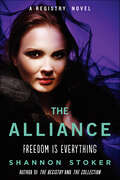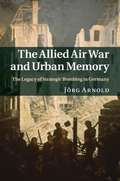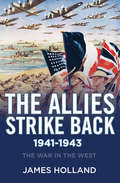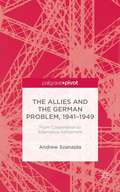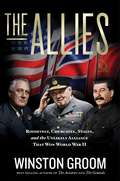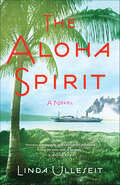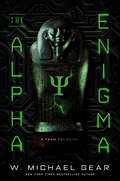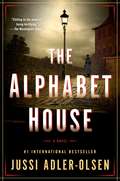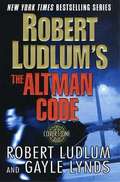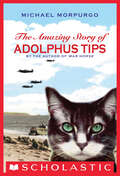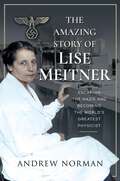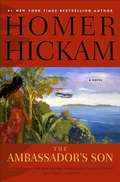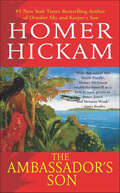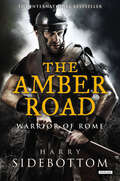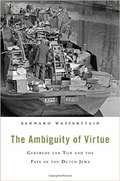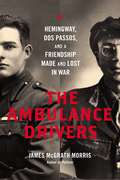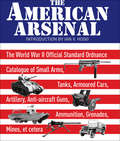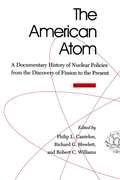- Table View
- List View
The Alliance: A Registry Novel (Registry Novels #3)
by Shannon StokerA rebel goes undercover in a desperate attempt to free her country from a brutal dictator in the final novel of this dystopian thriller trilogy.In America, the Registry weds girls to the highest bidder and raises boys for its army. Mia Morrissey fled to Mexico to claim her freedom. Now, she’s going risk everything so that the rest of America can be free.Going undercover as part of a diplomatic mission, Mia returns to an America even more dangerous than the one she left. The forgotten country faces its most ruthless leader yet, Grant Marsden—a shadow from Mia’s past. With the help of the subversive group Affinity, she embarks on a perilous journey to defeat Grant, bring down the government, and destroy the Registry once and for all.But when a terrible betrayal exposes the operation, Mia discovers that her enemies have used her—and so have her friends. Alone and frightened, Mia knows that her next step may be the last for her . . . and America.
The Allied Air War and Urban Memory
by Jörg ArnoldThe cultural legacy of the air war on Germany is explored in this comparative study of two bombed cities from different sides of the subsequently divided nation. Contrary to what is often assumed, Allied bombing left a lasting imprint on German society, spawning vibrant memory cultures that can be traced from the 1940s to the present. While the death of half a million civilians and the destruction of much of Germany's urban landscape provided 'usable' rallying points in the great political confrontations of the day, the cataclysms were above all remembered on a local level, in the very spaces that had been hit by the bombs and transformed beyond recognition. The author investigates how lived experience in the shadow of Nazism and war was translated into cultural memory by local communities in Kassel and Magdeburg struggling to find ways of coming to terms with catastrophic events unprecedented in living memory.
The Allied Bombing of Central Italy: The Restoration of the Nile Mosaic and Sanctuary of Fortuna at Palestrina (Routledge Studies in Second World War History)
by Teresa Fava ThomasThe Allied Bombing of Central Italy examines the results of the Second World War Allied bombing campaign on Palestrina and Rome, Italy, and the long-term impact of the war on the mountainside town and on the Barberini family's art collection including the Nile Mosaic. It explores the history and cultural significance of Palestrina, its strategic setting, the recovery of the town, the restoration of the Nile Mosaic, which remains the largest Egyptian-style mosaic extant. A unique aspect of the destruction was that it uncovered a pagan temple, the Sanctuary of Fortuna. The bombing destroyed the homes built on its terraces but revealed the ancient structure buried beneath which had remained unseen for half a millennium. It took more than a decade for the mosaic to be restored and the Sanctuary of Fortuna established as a national archeological museum. The book explores the pressure by the Mussolini regime to control the Barberini family's art collection, the uses of cultural materials for propaganda purposes, the Allied use of airpower in the Italian theater of war, the postwar decision-making and recovery process. The book is one of the very few long-range studies of the war's impact on a single Italian town. It is suitable for academic seminars and an educated general audience.
The Allied Bombing of Central Italy: The Restoration of the Nile Mosaic and Sanctuary of Fortuna at Palestrina (Routledge Studies in Second World War History)
by Teresa Fava ThomasThe Allied Bombing of Central Italy examines the results of the Second World War Allied bombing campaign on Palestrina and Rome, Italy, and the long-term impact of the war on the mountainside town and on the Barberini family's art collection including the Nile Mosaic. It explores the history and cultural significance of Palestrina, its strategic setting, the recovery of the town, the restoration of the Nile Mosaic, which remains the largest Egyptian-style mosaic extant. A unique aspect of the destruction was that it uncovered a pagan temple, the Sanctuary of Fortuna. The bombing destroyed the homes built on its terraces but revealed the ancient structure buried beneath which had remained unseen for half a millennium. It took more than a decade for the mosaic to be restored and the Sanctuary of Fortuna established as a national archeological museum. The book explores the pressure by the Mussolini regime to control the Barberini family's art collection, the uses of cultural materials for propaganda purposes, the Allied use of airpower in the Italian theater of war, the postwar decision-making and recovery process. The book is one of the very few long-range studies of the war's impact on a single Italian town. It is suitable for academic seminars and an educated general audience.
The Allies Strike Back: 1941-1943 (The War in the West)
by James HollandVolume two in this “expert, anecdote-filled, thoroughly entertaining” history of WWII follows The Rise of Germany as the Allied forces turn the tides (Kirkus).James Holland’s The Rise of Germany, the first volume in his War in the West trilogy, was widely praised for his impeccable research and lively narrative. Covering the dawn of World War II, it ended at a point when the Nazi war machine appeared to be unstoppable. Germany had taken Poland and France with shocking speed. London was bombed, and U-boats harried shipping on the Atlantic. But Germany hadn’t actually won the Battle of Britain or the Battle of the Atlantic. It was not producing airplanes or submarines fast enough. And what looked like victory in Greece and Crete had expended crucial resources in short supply.The Allies Strike Back continues the narrative as Germany’s invasion of Russia unfolds in the east, while in the west, the Americans formally enter the war. In North Africa, following major setbacks at the hands of Rommel, the Allies storm to victory. Meanwhile, the bombing of Germany escalates, aiming to not only destroy the its military, industrial, and economic system, but also relentlessly crush civilian morale. Comprehensive and impeccably researched, “Holland brings a fresh eye to the ebb and flow of the conflict” in this “majestic saga” of 20th century history (Literary Review, UK).
The Allies and the German Problem, 1941–1949: From Cooperation to Alternative Settlement
by Andrew SzanajdaThe Allies and the German Problem, 1941-1949 examines Allied policymaking during the Second World War and the military occupation of postwar Germany, demonstrating how the initial unity of the Allies disintegrated during the postwar military occupation in the face of their separate goals for postwar Germany and Europe.
The Allies: Roosevelt, Churchill, Stalin, and the Unlikely Alliance That Won World War II
by Winston GroomBest-selling author Winston Groom tells the complex story of how Franklin Roosevelt, Winston Churchill, and Joseph Stalin--the three iconic and vastly different Allied leaders--aligned to win World War II and created a new world order.By the end of World War II, 59 nations were arrayed against the axis powers, but three great Allied leaders--Franklin Roosevelt, Winston Churchill, and Joseph Stalin--had emerged to control the war in Europe and the Pacific. Vastly different in upbringing and political beliefs, they were not always in agreement--or even on good terms. But, often led by Churchill's enduring spirit, in the end these three men changed the course of history. Using the remarkable letters between the three world leaders, enriching narrative details of their personal lives, and riveting tales of battles won and lost, best-selling historian Winston Groom returns to share one of the biggest stories of the 20th century: The interwoven and remarkable tale, and a fascinating study of leadership styles, of three world leaders who fought the largest war in history.
The Aloha Spirit: A Novel
by Linda UlleseitThe spirit of aloha is found in Hawaii’s fresh ocean air, the flowers, the trade winds . . . the natural beauty that smooth the struggles of daily life. In 1922 Honolulu, unhappy in the adoptive family that’s raised her, Dolores begins to search for that spirit early on—and she begins by running away at sixteen to live with her newlywed friend Maria. Trying to find her own love, Dolores marries a young Portuguese man named Manolo His large family embraces her, but when his drinking leads to physical abuse, only his relative Alberto comes to her rescue—and sparks a passion within Dolores that she hasn’t known before. Staunch Catholics can’t divorce, however; so, after the Pearl Harbor attack, Dolores flees with her two daughters to California, only to be followed by both Manolo and Alberto. In California, Manolo’s drinking problems continue—and Alberto’s begin. Outraged that yet another man in her life is turning to the bottle for answers, Dolores starts to doubt her feelings for Alberto. Is he only going to disappoint her, as Manolo has? Or is Alberto the embodiment of the aloha spirit she’s been seeking?
The Alpha Enigma (Team Psi #1)
by W. Michael GearA thrilling new science fiction mystery from the New York Times bestselling author of the Donovan novelsDr. Timothy Ryan, head of the military psychiatric unit at Grantham Barracks, is meeting a new patient, a woman known as "Prisoner Alpha." As she is being transferred, they are attacked by assassins, barely escaping with their lives. One shooter vanishes, leaving behind a dead companion unlike anyone Ryan has ever seen.But even more baffling is the puzzle of Alpha herself. She speaks in a strange tongue, and doodles in bars, dots, and little pictures like nothing Ryan has ever seen. Is she some sort of savant, or the most cunning spy he's ever met?Meanwhile, in Egypt, archaeologist Reid Farmer uncovers an 18th-Dynasty tomb that shouldn't exist, filled with Mayan epigraphy, mathematics, and materials that didn't exist 3,000 years ago. As a result of this discovery, Reid and forensic anthropologist Kilgore France—along with the sarcophagus they have found—are snatched away to a hidden lab to solve the enigma of a man lost in time.As dark forces gather, Alpha makes an impossible escape from Grantham. Ryan quickly becomes the prime suspect in her disappearance, but with a team of unique allies, sets out to prove his innocence. Together, they must find Alpha and save Ryan before it is too late.
The Alphabet House
by Jussi Adler-OlsenIn the tradition of Alan Furst, the #1 international bestselling author delivers his first stand-alone novel, a psychological thriller set in World War II Nazi Germany and 1970s England British pilots James Teasdale and Bryan Young have been chosen to conduct a special photo-reconnaissance mission near Dresden, Germany. Intelligence believes the Nazis are building new factories that could turn the tide of the war. When their plane is shot down, James and Bryan know they will be executed if captured. With an enemy patrol in pursuit, they manage to jump aboard a train reserved for senior SS soldiers wounded on the eastern front.In a moment of desperation, they throw two patients off the train and take their places, hoping they can escape later. But their act is too convincing and they end up in the Alphabet House, a mental hospital located far behind enemy lines, where German doctors subject their patients to daily rounds of shock treatments and experimental drugs. The pilots' only hope of survival is to fake insanity until the war ends, but their friendship and courage are put to the ultimate test when James and Bryan realize they aren't the only ones in the Alphabet House feigning madness.Millions of fans around the world--and in this country--know Adler-Olsen for his award-winning Department Q series. His first stand-alone, The Alphabet House, is the perfect introduction for those who have yet to discover his riveting work.
The Altman Code (Covert-One #4)
by Robert Ludlum Gayle LyndsIN THE MIDDLE OF THE NIGHT, ON THE DARK WATERSIDE DOCKS OF SHANGHAI, a photographer is recording cargo being secretly loaded when he's brutally killed and his camera destroyed. Shortly thereafter Covert-One director Fred Klein brings word to the president that there's a Chinese cargo ship rumored to be carrying tons of chemicals to be used by a rogue nation to create new biological weapons. The president cannot let the ship land and risk the consequences of a new stockpile of deadly chemical weapons. Klein is ordered to get the president solid proof of what the Chinese ship is ferrying. Covert-One agent Jon Smith is sent to rendezvous in Taiwan with another agent, who lias acquired the ship's true manifest. But before Smith can get the document, the two agents are ambushed, the second agent is murdered, the proof is destroyed, and Smith escapes with only his life, scant clues to the mystery behind the cargo ship, and a verbal message - the president's biological father is still alive, held prisoner by the Chinese for fifty years. As the Chinese cargo ship draws ever closer to its end port, Smith must race against the clock to uncover the truth about the ship and its cargo, a truth that probes the deepest secrets of the Chinese ruling party, the faction in Washington working to undermine the elected government, and the international cabal who is thrusting the world to the very brink of war.
The Amazing Story of Adolphus Tips: Listen To The Moon, The Amazing Story Of Adolphus Tips, The Elephant In The Garden (Oberon Modern Plays Ser.)
by Michael MorpurgoFrom the author of Private Peaceful, a stunning novel about friendship, World War II, a naughty cat, and one girl&’s bravery which changes her life forever. It&’s 1943, and twelve-year-old Lily Tregenza lives on a farm in an idyllic seaside village in England. Apart from her father being away and the &“townie&” evacuees at school, her life is scarcely touched by the war. That is until Lily and her family, along with 3,000 other villagers, are ordered to evacuate their homes to allow the Allied forces to practice their landings for D-day. It&’s a dangerous operation—guns firing and bombs exploding—and the whole area is off-limits. But Adolphus Tips, Lily&’s adored cat, has other ideas—barbed wire and &“Keep out!&” signs mean nothing to her . . . Praise for The Amazing Story of Adolphus Tips&“The personal story of anger and love is as gripping as the war drama, and Morpurgo includes a fascinating note about the invasion rehearsal and why its history is seldom told.&” —Booklist
The Amazing Story of Lise Meitner: Escaping the Nazis and Becoming the World’s Greatest Physicist
by Andrew NormanThe book describes how Lisa Meitner, of Jewish heritage, found herself working as a physicist at the Kaiser Wilhelm Institute in Berlin when the Nazis came to power in 1933; how she was hounded out of the country and forced to relocate to Sweden; how German chemists Otto Hahn and Fritz Strassman continued with the project – on the effect of bombarding uranium (the heaviest known element at the time) with neutrons, a project which Lise herself had initiated, being the intellectual leader of the group. It describes how Hahn and Strassmann, with whom she kept in touch, came up with some extraordinary results which they were at a loss to explain; how Lise, and her nephew Otto Frisch, who was also a physicist, confirmed what they had achieved - the ‘splitting of the atom’, no less, and provided them with a theoretical explanation for it. This laid the foundation for nuclear power, medical-scanning technology, radiotherapy, electronics, and of course, the atomic bomb - the creation of which filled Lise with horror. It describes the crucial part that Lise played in our understanding of the world of atoms, and how deliberate and strenuous attempts were made to deny her contribution; to belittle her achievements, and to write her out of the history books, even though Albert Einstein said she was even ‘more talented than Marie Curie herself’. The author is fortunate and honoured to have been granted several interviews with Lise’s nephew Philip Meitner – himself a refugee from the Nazis - who with his wife Anne, provided much valuable information and many photographs.
The Amazon Quest (House of Winslow #25)
by Gilbert MorrisThe Perils of the Amazon Reveal the Depths of the Heart's Entanglements. . . . Emily Winslow meets James Parker, the man who tried to save her brother's life in the trenches of World War I in France, and she and her family feel deeply indebted to him. They offer to help him in any way they can to get a new start after recovering from his own wounds. By the time the family is confronted with the surprising truth of what actually happened on that distant battlefield, Emily has fallen in love with James. Overwhelmed by bitterness and the betrayal of her love, Emily throws herself into her writing career. When an opportunity comes to travel deep into the Amazon rain forest and record the life of an isolated tribe of headhunters, she readily accepts the challenge. But all of her inner turmoil returns with a vengeance when Ian Marlowe walks into her life. Is Emily's faith strong enough to sustain her? Can she trust her heart this time around?
The Ambassador's Son
by Homer HickamIn 1943, the Americans and Japanese are fighting a deadly war. Now a blow has fallen on American morale. Lieutenant Armistead, cousin of the president is missing, and may have gone over to the enemy.
The Ambassador's Son (Josh Thurlow #2)
by Homer HickamIt's 1943 and the Americans and Japanese are fighting a deadly war in the hot, jungle-covered volcanic islands of the South Pacific. The outcome is in doubt and a terrible blow has fallen on American morale. Lieutenant David Armistead, a Marine Corps hero and cousin of the President of the United States, is missing and some say he's gone over to the enemy. Coast Guard Captain Josh Thurlow and his ragtag crew are given the assignment to find Armistead, though not necessarily to bring him back alive. Recruited in the hunt is a tormented and frail PT-boat skipper nicknamed "Shafty" who is also known by another name: John F. Kennedy. When Josh is stranded in the jungles of New Georgia with a mysterious, sensual woman who has a tendency to chop off men's heads, it's up to Kennedy to come to the rescue and complete the mission. But to procure a gunboat, he first has to play high-stakes poker with a young naval supply officer called Nick who happens to be the best gambler in the South Pacific. Nick has another name, too: Richard M. Nixon. Based solidly on historical fact with echoes of James Michener, The Ambassador'sSon is a thrilling tale of the South Pacific and adventure fiction at its finest.
The Amber Road: Warrior of Rome (Warrior Of Rome Ser. #6)
by Harry SidebottomA warrior in enemy territory is on secret mission to raise an army in this historical adventure by the author of Wolves of the North. In AD 264, the Roman Empire has been torn in two. The western provinces—Gaul, Spain, and Britain—have been seized by Postumus, the pretender to the throne. To the east, on the plains of northern Italy, the armies of the emperor Gallienus muster, and he is keen to take his rightful place of power. A war between two emperors is coming, and everyone must choose a side. On a mission shrouded in secrecy and suspicion, Ballista is sent by Gallienus back to his original home of Hyperborea, the place of the people of his birth, to raise an army against Postumus. This means that Ballista must journey along the Amber Road to the far north. Along the way Ballista meets a fearsome, masked warlord who brings fire and sword against Ballista and his men. And in Ballista&’s home of Hyperborea, not all welcome his return. In the battle between Postumus and Gallienus, only one can survive and be emperor. Renowned for their skilled blending of action and historical accuracy, Sidebottom&’s Warrior of Rome novels take the reader from the shouts of the battlefield to the whisperings of the emperor&’s inner circle. Rich in detail and punctuated by harrowing action, there&’s no better way to transport yourself back to the days of the Roman Empire.Praise for the Warrior of Rome series&“Sidebottom&’s prose blazes with searing scholarship.&” —The Times (UK)&“Superior . . . fiction, with depth, authenticity and a sense of place.&” —Times Literary Supplement (UK)&“A storming Roman epic with explosive action and knuckle-whitening drama.&” —The Guardian (UK)&“I don&’t think I&’ve ever experienced antiquity so directly: the brutality, the directness of expression and feeling, the deep bonds formed amid unmitigated violence.&” —David Konstan, Professor of Classics, Brown University&“The best sort of red-blooded historical fiction.&” —Andrew Taylor, author of The American Boy
The Ambiguity of Virtue
by Bernard WassersteinIn May 1941, Gertrude van Tijn arrived in Lisbon on a mission of mercy from Germanâe#144;occupied Amsterdam. She came with Nazi approval to the capital of neutral Portugal to negotiate the departure from Hitler's Europe of thousands of German and Dutch Jews. Was this middleâe#144;aged Jewish woman, burdened with such a terrible responsibility, merely a pawn of the Nazis, or was her journey a genuine opportunity to save large numbers of Jews from the gas chambers? In such impossible circumstances, what is just action, and what is complicity? A moving account of courage and of all-too-human failings in the face of extraordinary moral challenges, The Ambiguity of Virtue tells the story of Van Tijn's work on behalf of her fellow Jews as the avenues that might save them were closed off. Between 1933 and 1940 Van Tijn helped organize Jewish emigration from Germany. After the Germans occupied Holland, she worked for the Naziâe#144;appointed Jewish Council in Amsterdam and enabled many Jews to escape. Some later called her a heroine for the choices she made; others denounced her as a collaborator. Bernard Wasserstein's haunting narrative draws readers into the twilight world of wartime Europe, to expose the wrenching dilemmas that confronted Jews under Nazi occupation. Gertrude van Tijn's experience raises crucial questions about German policy toward the Jews, about the role of the Jewish Council, and about Dutch, American, and British responses to the persecution and mass murder of Jews on an unimaginable scale.
The Ambulance Drivers: Hemingway, Dos Passos, and a Friendship Made and Lost in War
by James Mcgrath MorrisAfter meeting for the first time on the front lines of World War I, two aspiring writers forge an intense twenty-year friendship and write some of America's greatest novels, giving voice to a "lost generation" shaken by war.Eager to find his way in life and words, John Dos Passos first witnessed the horror of trench warfare in France as a volunteer ambulance driver retrieving the dead and seriously wounded from the front line. Later in the war, he briefly met another young writer, Ernest Hemingway, who was just arriving for his service in the ambulance corps. When the war was over, both men knew they had to write about it; they had to give voice to what they felt about war and life.Their friendship and collaboration developed through the peace of the 1920s and 1930s, as Hemingway's novels soared to success while Dos Passos penned the greatest antiwar novel of his generation, Three Soldiers. In war, Hemingway found adventure, women, and a cause. Dos Passos saw only oppression and futility. Their different visions eventually turned their private friendship into a bitter public fight, fueled by money, jealousy, and lust.Rich in evocative detail--from Paris cafes to the Austrian Alps, from the streets of Pamplona to the waters of Key West--The Ambulance Drivers is a biography of a turbulent friendship between two of the century's greatest writers, and an illustration of how war both inspires and destroys, unites and divides.
The American Adventuress: A Novel
by C. W. Gortner"No one writes bright, bold, bad, and beautiful women of history like C.W. Gortner, and he outdoes himself with his latest heroine: Jennie Jerome, American heiress, royal mistress, and mother of Winston Churchill. The American Adventuress shines on every page with Jennie's irrepressible thirst for adventure, love, and everything else life has to offer!" -- Kate Quinn, New York Times bestselling author of The Rose CodeThe story of Jennie Jerome Churchill, mother of Winston, a New York born heiress who always lived life on her own terms.Daughter of New York financier Leonard Jerome, Jennie was born into wealth—and scandal. Upon her parents’ separation, her mother took Jennie and her sisters to Paris, where Mrs. Jerome was determined to marry her daughters into the most elite families. The glamorous city became their tumultuous finishing school until it fell to revolt. Fleeing to Queen Victoria’s England, Jennie soon caught the eye of aristocrat Randolph Spencer-Churchill, son of the Duke of Marlborough, one of Britain’s loftiest peers. It was love at first sight, their unconventional marriage driven by mutual ambition and the birth of two sons. Undeterred by premature widowhood or society’s rigid expectations, Jennie brashly carried on a lifelong intimate friendship with Edward, Prince of Wales—a notorious bon vivant—and had two later marriages to younger men. When her son Winston launched his brilliant political career, Jennie guided him to success, his most vocal and valuable supporter.By turns scandalous, tragic, and exciting, Jennie Jerome lived an unconventional life full of defiance—one that enshrined her as an American adventuress.
The American Arsenal: The World War II Official Standard Ordnance Catalogue of Small Arms, Tanks, Armoured Cars, Artillery, Anti-aircraft Guns, Ammunition, Grenades, Mines, et cetera
by Ian V. HoggDuring WWII, various U.S. military agencies produced catalogues of equipment to fill the gaps left by the official War Department manuals, which led to inconsistent data appearing in different sources. In order to standardize information and properly catalogue all the equipment, the U.S. Ordnance Department put together a master guide, published here as The American Arsenal. All the information was checked and authenticated by reference to Ordnance Committee Minutes and similar authorities. No other single source provides so much accurate and authentic detail on U.S. weapons, ammunition, vehicles and other combat equipment, with an authoritative explanation of their development and introduction processes. Profusely illustrated with over 900 photographs and drawings, the facts and figures are set in context in the introduction by weapons expert Ian V. Hogg. This is an invaluable reference work for those interested in the military equipment of WWII.
The American Atom: A Documentary History Of Nuclear Policies From The Discovery Of Fission To The Present (Second Edition)
by Robert C. Williams Philip L. Cantelon Richard G. HewlettEver since the late 1930s, scientists have been sharply divided on the question of atomic energy. It is hardly surprising, then, that the American public is so apprehensive about its use. Hack M. Holl, former chief historian a the U. S. Department of Energy, characterizes the furor over nuclear energy as "one of the great debates in American history. " In this second edition of The American Atom, the editors have updated the collection of primary documents that tell the story of atomic energy in the United States from the discover of fission through the development of nuclear weapons, international proliferation, and attempts at control. Anyone interested in the evolution of the issues will want to examine the book's major sections on the Manhattan Project, the Oppenheimer Case, the hydrogen bomb, nuclear testing and the test ban, proliferation, arms control, and the strategy of deterrence.
The American Bar Association Legal Guide for Military Families
by American Bar AssociationThe one and only legal guide for servicemembers and their families.The American Bar Association Legal Guide for Military Families is the complete resource for servicemembers, veterans, and their families. This guide will help all servicemembers clarify their legal issues, understand the options, and locate assistance. Topics are presented in an easy-to-read format and every chapter includes a resources section with phone numbers, websites, and contacts to help servicemembers find answers and move forward. Topics include:· Working with a Lawyer · Family Law · Debt and Finance · Housing, Landlord/Tenant Issues, and Real Estate · Motor Vehicle Sales, Finance, and Repair · Estate Planning and Insurance · Health Care Law · Employment and Re-employment · Discharge · Disability Issues · Veterans Benefits The American Bar Association Legal Guide for Military Families is a supplement to the popular ABA Homefront website that provides state-by-state legal information for servicemembers. Visit www.abahomefront.com.
The American Black Chamber
by Herbert O. YardleyDuring the 1920s Herbert O. Yardley was chief of the first peacetime cryptanalytic organization in the United States, the ancestor of today's National Security Agency. Funded by the U.S. Army and the Department of State and working out of New York, his small and highly secret unit succeeded in breaking the diplomatic codes of several nations, including Japan. The decrypts played a critical role in U.S. diplomacy. Despite its extraordinary successes, the Black Chamber, as it came to known, was disbanded in 1929. President Hoover's new Secretary of State Henry L. Stimson refused to continue its funding with the now-famous comment, "Gentlemen do not read other people's mail." In 1931 a disappointed Yardley caused a sensation when he published this book and revealed to the world exactly what his agency had done with the secret and illegal cooperation of nearly the entire American cable industry. These revelations and Yardley's right to publish them set into motion a conflict that continues to this day: the right to freedom of expression versus national security. In addition to offering an expose on post-World War I cryptology, the book is filled with exciting stories and personalities.
